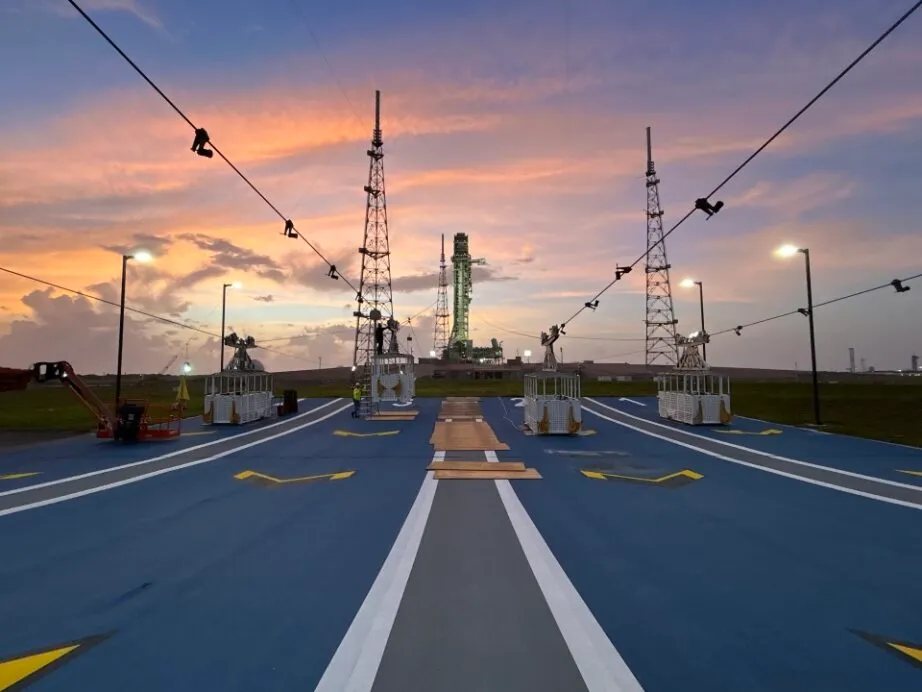Introduction
NASA’s Artemis program marks a significant leap in human space exploration, with the ambitious goal of returning astronauts to the Moon and eventually paving the way for Mars exploration. Central to this program’s success is ensuring the safety and well-being of the crew throughout their mission. One of the crucial aspects of this safety protocol is the Artemis Emergency Egress System (EES), a sophisticated safety measure designed to protect astronauts in case of an emergency during launch and pre-launch operations. This article provides an in-depth exploration of the Artemis Emergency Egress System, its design, functionality, and the critical role it plays in ensuring crew safety.
Overview of the Artemis Program
Before delving into the specifics of the Emergency Egress System, it’s important to understand the broader context of the Artemis program.
1. Artemis Mission Objectives
The Artemis program is NASA’s initiative to return humans to the Moon and establish a sustainable presence. Key objectives include:
- Lunar Exploration: Conducting scientific research on the Moon’s surface and understanding its resources.
- Sustainable Presence: Establishing long-term human exploration capabilities and infrastructure on the Moon.
- Mars Preparation: Using lunar exploration as a stepping stone for future manned missions to Mars.
2. The Artemis I, II, and III Missions
- Artemis I: An uncrewed mission that tested the Space Launch System (SLS) rocket and Orion spacecraft in a lunar orbit.
- Artemis II: The first crewed mission in the Artemis program, aimed at testing the Orion spacecraft’s systems and life-support capabilities on a lunar flyby.
- Artemis III: The mission that plans to land astronauts on the Moon’s surface, including the first woman and the next man.
The Artemis Emergency Egress System: Ensuring Safety
The Artemis Emergency Egress System is a vital component of the safety measures designed to protect astronauts during high-risk phases of the mission. This system ensures that the crew can safely escape from the launch pad in the event of an emergency.
1. Purpose and Importance
The primary purpose of the Emergency Egress System is to provide a rapid and safe evacuation route for astronauts if an emergency occurs during pre-launch or launch operations. Its design is critical to mitigating risks and ensuring that the crew can quickly and safely exit the launch vehicle.
- Emergency Scenarios: Potential emergencies include rocket malfunctions, launch pad fires, or any other unforeseen incidents that could jeopardize crew safety.
- Safety Protocols: The EES is part of a comprehensive safety protocol that includes numerous checks and procedures to protect astronauts during all stages of the mission.
2. Components of the Emergency Egress System
The Artemis EES comprises several key components, each designed to ensure a safe and efficient evacuation process.
- Launch Escape System (LES): The LES is a rocket-propelled system designed to quickly propel the crew module away from the launch vehicle in case of an emergency. This system is equipped with powerful solid rocket motors that can lift the module to a safe distance.
- Crew Access Arm and Egress Platforms: The crew access arm provides astronauts with a path to enter and exit the spacecraft. In the event of an emergency, egress platforms allow crew members to quickly evacuate the spacecraft.
- Egress Ropes and Slides: Egress ropes and slides are used for quick descent from the launch pad. These are critical for ensuring that astronauts can safely and swiftly evacuate from the spacecraft and reach a safe area.
- Emergency Procedures and Training: Astronauts undergo extensive training on emergency egress procedures, including simulations and drills to practice using the EES components. This training ensures that crew members are prepared to act quickly and efficiently in an emergency.
Design and Development of the Emergency Egress System
The design and development of the Artemis Emergency Egress System involve rigorous testing and evaluation to ensure its effectiveness and reliability.
1. Engineering and Testing
- Simulations: Engineers conduct detailed simulations to test the performance of the EES under various emergency scenarios. These simulations help identify potential issues and ensure that the system functions as intended.
- Physical Testing: The EES undergoes physical testing, including mock-up evacuations and stress tests, to validate its design and operational capabilities. These tests involve recreating emergency conditions to assess the system’s response and effectiveness.
- Integration with Spacecraft and Launch Vehicle: The EES must be seamlessly integrated with the Orion spacecraft and the Space Launch System (SLS). Engineers ensure that all components work together smoothly and that the system can be activated quickly in an emergency.
2. Safety Standards and Regulations
The design and implementation of the EES adhere to stringent safety standards and regulations set by NASA and other regulatory bodies.
- Safety Certifications: The system undergoes rigorous certification processes to ensure that it meets all safety and performance standards. This includes compliance with NASA’s safety requirements and industry best practices.
- Continuous Improvement: The EES design is continuously reviewed and updated based on feedback from testing and operational experiences. This iterative process ensures that the system remains up-to-date and effective in addressing emerging safety concerns.
The Role of the Emergency Egress System in Crew Safety
The Artemis Emergency Egress System plays a crucial role in ensuring the safety of astronauts during the critical phases of a mission.
1. Pre-Launch Safety
During pre-launch operations, the EES provides astronauts with a safe means of evacuation in case of an emergency. This is particularly important during the final stages of the countdown, when the crew is onboard the spacecraft and preparing for launch.
- Evacuation Drills: Astronauts regularly participate in evacuation drills to practice using the EES and familiarize themselves with emergency procedures. These drills help ensure that crew members can quickly and effectively respond to emergencies.
- Emergency Readiness: The EES is equipped with multiple redundancies and backup systems to ensure readiness in case of unexpected situations. This includes backup power sources and alternative evacuation routes.
2. Launch Phase Safety
During the launch phase, the EES is activated if an emergency situation arises that jeopardizes the safety of the crew. The Launch Escape System (LES) provides a rapid and reliable means of escaping from the launch vehicle.
- Quick Response: The LES is designed to activate within seconds of detecting an emergency, providing a swift and efficient means of escape. This quick response is crucial for minimizing risks and ensuring crew safety.
- Safe Separation: The LES ensures that the crew module is safely separated from the launch vehicle and propelled to a safe distance. This separation is essential for protecting the crew from potential hazards, such as explosions or fires.

Training and Preparedness
Ensuring that astronauts are well-prepared to use the Emergency Egress System is a critical aspect of mission safety.
1. Astronaut Training Programs
Astronauts undergo extensive training programs to familiarize themselves with the EES and emergency procedures. This training includes:
- Simulation Exercises: Astronauts participate in realistic simulations of emergency scenarios to practice using the EES. These exercises help build familiarity with the system and improve response times.
- Drills and Rehearsals: Regular drills and rehearsals are conducted to ensure that astronauts are prepared to act quickly and efficiently in an emergency. These drills involve practicing egress procedures, including using ropes, slides, and access platforms.
- Emergency Protocols: Astronauts are trained on emergency protocols, including communication procedures and coordination with ground control. This training ensures that astronauts can effectively manage emergencies and work with mission control to resolve issues.
2. Collaboration with Ground Control
Ground control plays a crucial role in coordinating emergency responses and supporting the crew during high-risk situations.
- Real-Time Monitoring: Ground control monitors the launch and pre-launch operations in real-time, providing support and guidance to the crew. In the event of an emergency, ground control communicates with the astronauts and coordinates the activation of the EES.
- Crisis Management: Ground control is responsible for managing crises and ensuring that all necessary resources and support are available to the crew. This includes coordinating evacuation procedures, providing medical support, and managing communication with external agencies.
The Broader Impact of the Emergency Egress System
The Artemis Emergency Egress System not only enhances crew safety but also contributes to the overall success of the Artemis program and future space exploration missions.
1. Advancing Safety Standards
The development and implementation of the EES represent significant advancements in space safety standards. The lessons learned from the Artemis program will inform future missions and contribute to the continuous improvement of safety protocols.
- Innovation in Safety Technology: The EES incorporates cutting-edge technologies and innovative solutions to address safety challenges. These advancements contribute to the broader field of space exploration and improve safety standards for future missions.
- Global Collaboration: The Artemis program and its safety measures demonstrate the importance of international collaboration in space exploration. Partnering with other space agencies and organizations helps to advance safety standards and share knowledge and expertise.
2. Inspiring Future Exploration
The Artemis Emergency Egress System is a testament to the commitment to crew safety and the pursuit of space exploration. It inspires future generations of scientists, engineers, and explorers to continue pushing the boundaries of space exploration.
- Educational Outreach: NASA and its partners use the EES and other safety innovations as educational tools to inspire and engage students and the public. By showcasing advancements in space safety, NASA promotes interest in STEM fields and encourages future generations to pursue careers in space exploration.


















































Discussion about this post